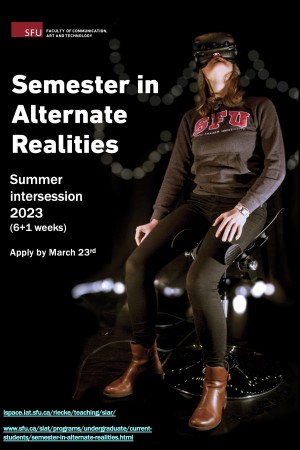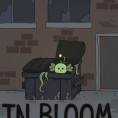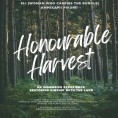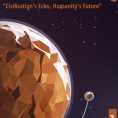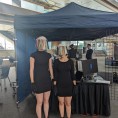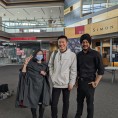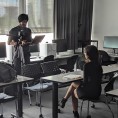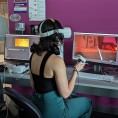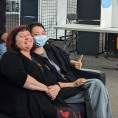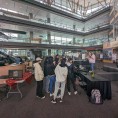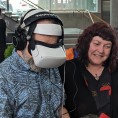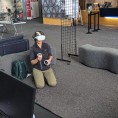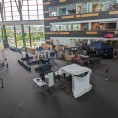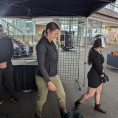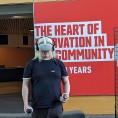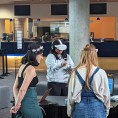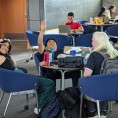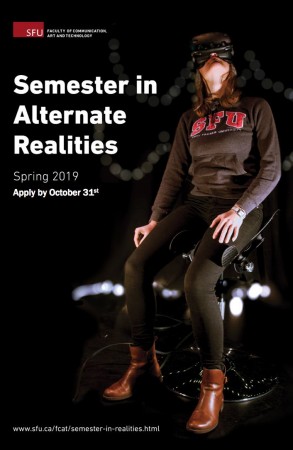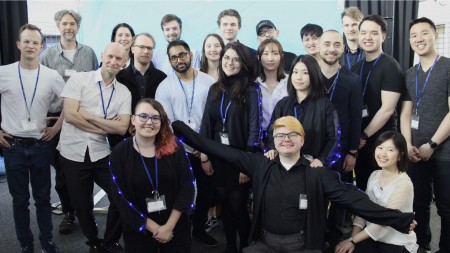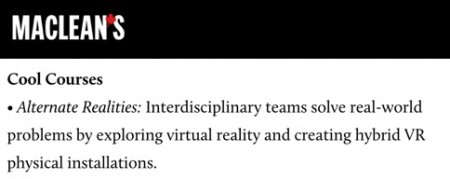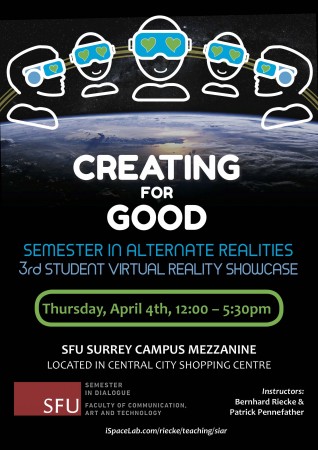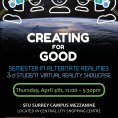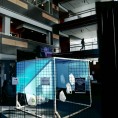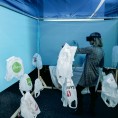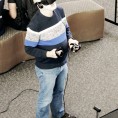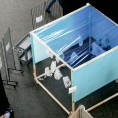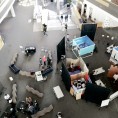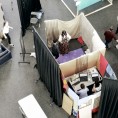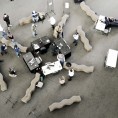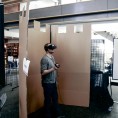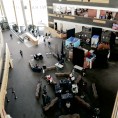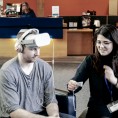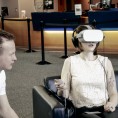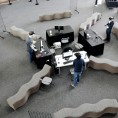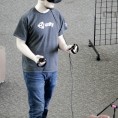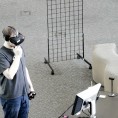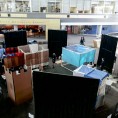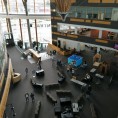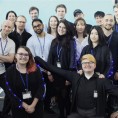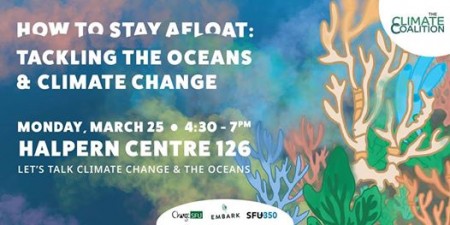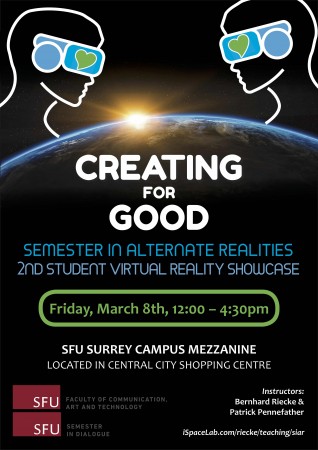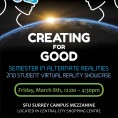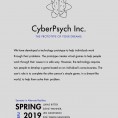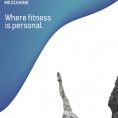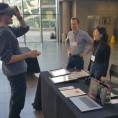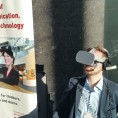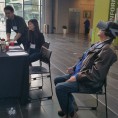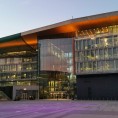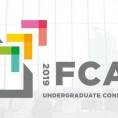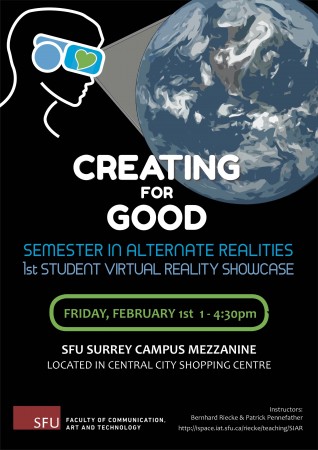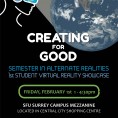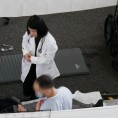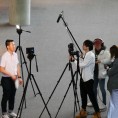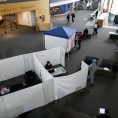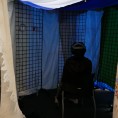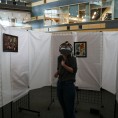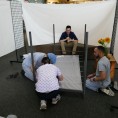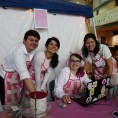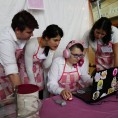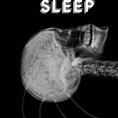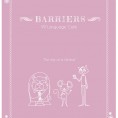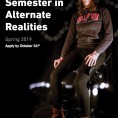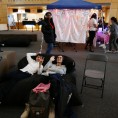About the Semester in Alternate Realities
Semester in Alternate Realities (SIAR) proposes a unique educational experience meant to inspire interdisciplinary teams to solve a real-world problem exploring Virtual reality (VR) and hybrid VR physical installations. In this project-based course, participants will be challenged to develop solutions using technologies such as VR (e.g., Meta Quest head-mounted displays) and immersive multi-modal media installations. In addition to focusing on the co-construction of digital prototypes affording meaningful experiences in “alternate realities”, our objective is to stimulate documented reflection and discussion throughout the process. Participants can expect to work collaboratively, be matched according to the skills they bring, and be provided time and resources to learn new techniques and approaches, soft– and hard skills, and processes to conduct user research.
Participants will get the opportunity to reflect on future technologies and their potential impact on the world, and improve their presentation skills and publicly showcase their projects. To incorporate diverse perspectives, students from different disciplines are invited to apply and, in their application, argue how they could contribute to the course and the co-construction of team projects.
Below are a few student quotes from the SIAR 2019 offering:
- The most unique and engaging semester I’ve had in my university career so far
- A once in a lifetime opportunity to learn new skills, make new friends, and work with technology for the greater good
- The most intensive course at SFU where students get hands on experience with cutting edge technology
- I actually know everybody’s name
- It’s a unique experience where the class actually feels like a community
- The most intensive course at SFU where students get hands on experience with cutting edge technology
Below is a first presentation from Bernhard about the instructional ideas behind the Semester in Alternate Realities, from his presentation on “Navigating the Dance of Power: Agency, Authenticity, and the Classroom” presented at Simon Fraser University’s Teaching Innovation Lab: Students as Partners in Teaching and Learning, on 29 August 2023. This talk covers some reflections, insights and teaching approaches from the Semester in Alternate Realities class he taught in 2019 and 2023
more recently Bernhard also presented at the SFU-SIAT research colloquium on Sept 20, 2023, on“Beyond Plagiarism Concerns: ChatGPT as Your Personal Coach in Education? Exploring the transformative potential of AI in education”. This talk covers insights and reflections on how students in his Semester in Alternate Realities project-based VR course used ChatGPT, discussing the potential and challenges of GenAI in higher education:
Publications
A reflection on SIAR 2023: Immersive Transformations in Project-Based Learning: Fostering Lifelong Learning and Empowerment through Virtual Reality and Ungrading Pedagogy
Simon Fraser University’s Semester in Alternate Realities (SIAR), an upper-level intensive course cross-listed for graduate students, is a ground-breaking endeavor in immersive learning. By harnessing Virtual Reality (VR) technology, project-based learning, and a radical ungrading approach, the course provides a comprehensive experience that blends innovative instructional methodologies, technological prowess, and the audacity to challenge traditional grading systems. This multifaceted design lays the foundation for the complex, yet transformative journey that defines the SIAR course experience.
Central to our design approach for SIAR was the use of transformative experience design frameworks. While these frameworks were employed to help students design more impactful VR experiences, they also served as a blueprint for creating a meaningful and transformative learning environment. The objective was not only to design specific moments in the classroom that might leave a lasting impact on students including deep learning, but also to potentially trigger personal and academic transformations. The major assessment was a team VR project (4 people/team) that provided the overarching learning and teaching context in this course.
This vision materialized in the agile learning environment we created, following a sprint framework with weekly feedback milestones. This setup compelled students to quickly adapt to new technologies, formulate strategies, present and user-test a minimal viable prototype (MVP) each week, and integrate user feedback and self/team-reflection insights into their projects and team management. As a result, students designed four distinct VR projects, each providing a unique, meaningful VR experience as evidenced in the public VR showcase. For instance, “In Bloom” is a VR puzzle game developed by a student team where players collaborate with a mystical creature to rejuvenate a desolate city, encapsulating our course’s emphasis on building a deeper connection between the user and their environment.
Reflecting on the transformative moments experienced in the course or while undertaking the team project, one student stated,
“I faced many challenges and overcame them by using one skill: adaptability. (…) Adaptation allowed me to work and learn at the same time and become a better programmer and student. Learning this lesson will surely be important for my future, both in academic and professional careers.” This testament underscores the profound personal and academic growth facilitated by the team project requirements, our agile learning framework, and the transformative design of the SIAR course (which includes the upgrading approach).
Another aspect of our transformative course design was fostering reflective discussions throughout the course. These discussions enabled students to collaboratively address real-world issues through VR, which was exemplified in “EcoSpectra”, which took immersants on a journey in a dystopian future museum, emphasizing the grim consequences of neglecting environmental preservation.
We designed SIAR with the aim of providing a compassionate and nurturing environment, which is evidenced through students’ experiences. By integrating connection-before-content and team/community building activities with bi-weekly individual and team coaching sessions and our ungrading approach, we encourage a mindset of creative exploration and compassionate understanding, promoting a sense of community and connection, and fostering a climate where students feel comfortable taking risks. A student’s reflection encapsulates this transformative impact, stating “the special thing about this class is that we get to make mistakes and we’re kind of not afraid to make those mistakes and we try things that we usually don’t try”.
The power of this communal spirit is further underlined by another student’s account of the team building activity that they were asked to design as part of SIAR, which marked a significant turning point in their project: “The day we went picnicking for team bonding is the day our initial direction was shut down, which is also the day we came up with the idea for EcoSpectra. The originally stressful day surprisingly turned out to be my most memorable day of the term. The moment we pulled out a blanket from nowhere, sat down at Burnaby Mountain Park having a picnic that none of us planned, while writing VRDD on a laptop that’s connected to somebody’s hotspot, and being bitten by mosquito as the sun went down, was the moment that I realize I won’t regret working with the people in my team.”
Students had the liberty to explore VR’s expansive potential, and they designed emotionally resonant experiences that offered novel perspectives unattainable in the physical world. For example, “Last Call to Elysium” presented a cautionary sci-fi narrative about our potential future if humanity fails to address the pressing climate crisis. Conversely, “Honourable Harvest” guided users on a journey of discovery and kinship with sacred medicines and plant relatives, embodying Indigenous teachings.
The impact of in-class activities guided by transformative experience design frameworks was evident when one student said, “As a student with constant design practices in visual communication, I tend to fixate on whatever the eyes perceive which usually makes me ignore the power of words, voice, and sounds. Bernhard mentioned that telling a story can be one of the oldest ways of immersion. During the session of Wizard-of-Ozing the potential ending for our project, especially after listening to a fellow student’s inner voice narration, I had an even more firm stand on the power of storytelling and desire to utilize it for future design practices.” This reflects the deep-seated paradigm shifts catalyzed by the course, highlighting its role as a potentially transformative educational model.
Integral to the SIAR experience is cultivating a sense of ownership and autonomy, instilling a passion that propels students to steer their own learning journeys supported by regular mentoring and coaching from the instructional team. This approach enables students to take the reins of their projects, fostering a sense of pride, ownership, and personal investment in their work. They conduct research, perform user testing, and synthesize data based on their understanding, fostering crucial self-management skills. The impact of this self-guided approach is captured eloquently in a student’s reflection: “One of the most significant skills I acquired throughout this class was self-management…I took the initiative to conduct research, perform user testing, and synthesize data not solely because they were assigned, but because I understood their inherent necessity based on my knowledge and experience.” This student testimony underscores the profound personal and academic growth sparked by the SIAR course’s student-driven approach to learning.
In conclusion, SIAR is more than a course; it’s a transformative journey towards lifelong learning. It shapes education in such a way that it not only inspires students to learn, create, and grow but also challenges and equips them to navigate the complexities of our rapidly evolving society. Through the shared experiences and transformative moments of our students, we believe in the power of SIAR to redefine immersive learning in a supportive, innovative, and engaging environment.
Semester in Alternate Realities: Showcase on Wednesday June 14 2023
On Wednesday June 14 2023, four student teams showcased their immersive Virtual Reality projects in the Mezzanine on our SFU Surrey campus, from ca 12:30 — 4:30pm. (see also Facebook event page)
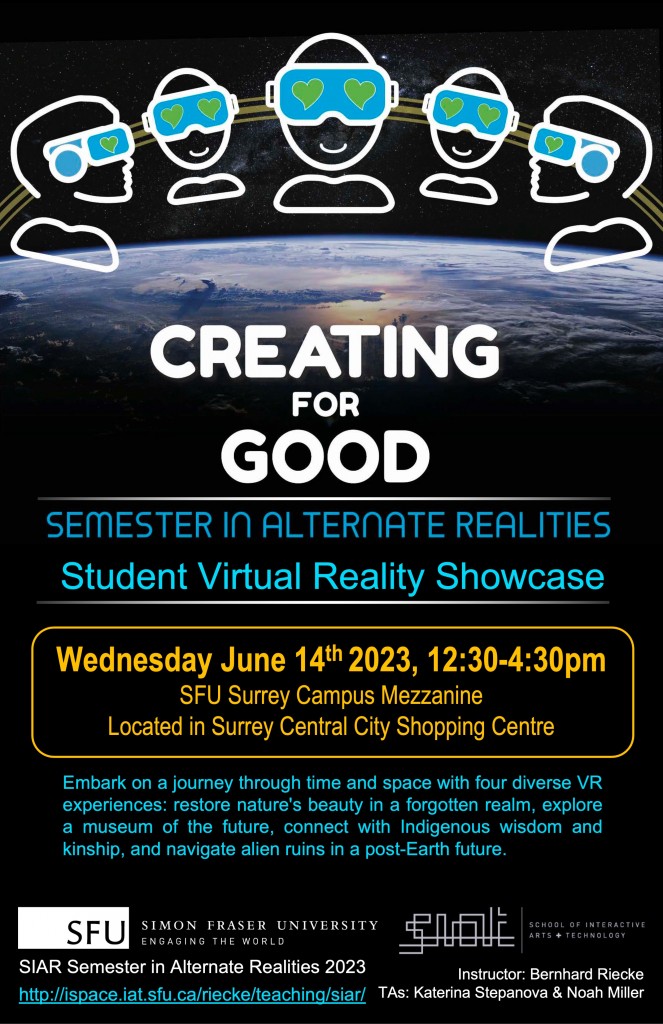
Details about the VR Projects:
In Bloom
Immerse yourself in a realm of captivating beauty and journey alongside a mystical creature as you unravel the mysteries of the forgotten planet, each step guiding you towards a shared goal: Restoring Nature.
Reconnect with nature, and restore life to a desolate city.
Razor: A VR puzzle game in which the player builds a bond with a magical wild animal, as they work together to restore nature in a desolate city.

Immerse yourself in a realm of captivating beauty and journey alongside a mystical creature as you unravel the mysteries of the forgotten planet, each step guiding you towards a shared goal: Restoring nature’s beauty to the world. Through our VR experience we hope to help users build a deeper connection between themselves and their environment.
In Bloom, is a puzzle based game in which the user cooperates alongside a mythical creature and aids them to unravel the mysteries of the ruined forgotten planet, each step guiding to the goal of restoring nature’s beauty to the world. Through our VR experience we hope to help users build a deeper connection between themselves and their environment.
Project video trailer:
Full project video:
EcoSpectra
Where the future meets the past
Brace yourself for a mind-bending journey through history in the EcoSpectra museum.
Razor: An educational and informative immersive experience that calls to action for environmental protection.
EcoSpectra is an immersive VR experience in which the user finds themselves in a museum with artifacts that you would see in any museum, but as they walk they start to see things that would be too ordinary to see in a museum today. This suspension leads to a twist where they find out they are a robot in a dystopian future where humans have led their species to an extinction. The purpose of this VR experience is to use the shock effect to make the user feel the possible future. The goal is to raise environmental awareness and highlight the consequences of not preserving the Earth.
Project video trailer:
Full project video:
Honourable Harvest
Re-igniting & restoring kinship with the land.
Through this experience, the immersant is transformed by Indigenous ways of knowing, being and doing, through gifting protocols and reciprocity, respect, and reverence for human and non-human kinship.
Razor: Using Indigenous teachings, Honourable Harvest guides users on a four-fold journey of discovery and kinship with sacred medicines and our plant relatives.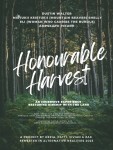
Honourable Harvest is an experience that allows users to travel east-south-west-and north across time, to build connection to, and to gather 4 sacred medicines and their stories as relatives/kin, as they prepare for smudging. at a meeting, event, or ceremony. Through this experience, the immersant learns more about Indigenous ways of knowing, being and doing, and will experience the essence of human and non-human kinship relations.
Project video trailer:
Full project video:
Last Call to Elysium
A civilization’s echo, Humanity's future
Venture into the vast cosmos, decipher alien ruins, and unlock the cautionary tales of civilizations past in 'Last Call to Elysium', a narrative journey through potential futures shaped by the climate crisis.
Razor: A sci-fi environmental storytelling narrative that explores planets filled with alien ruins; a hopeful, yet cautionary tale of potential futures humanity may face should it not address the current climate crisis.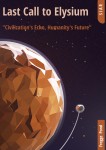
Last Call to Elysium is a sci-fi exploration experience set in a distant future where Earth has become inhabitable. Participants will take on the role of an astroconductor seeking to find a new home for humanity. Guided by an advanced navigation system which targets potential “goldilocks planets”, they will travel through wormholes on their spacetrain. Once they have landed on a planet, participants may explore the environments, and the ruins of past alien civilizations. Through their exploration, participants will be able to uncover the stories of these civilizations, and what led to their ultimate demise. By uncovering their pasts, participants will be able to learn from the mistakes of these alien civilizations, and gain a newfound appreciation for Earth.
Project video trailer:
Full project video:
Project Posters
Photos from 2023 SIAR showcase
Most recent offering: Summer intersession 2023
Bernhard will be offering an intensive (6 week + 1 week for final showcase) 6-credit version of the Semester in Alternate Realities in Summer (intersession) 2023, under the course numbers IAT 480 or 481, on the SFU Surrey Campus (next to the Skytrain Surrey Central station), see https://www.sfu.ca/siat/programs/undergraduate/current-students/semester-in-alternate-realities.html for more details.
Who can apply
Upper-level undergraduate and graduate students with a keen interest in addressing real-world problems through designing alternate realities experiences. Students are expected to be fearless in their exploration, adoption and experimentation of immersive technologies, and open to and interested in exploring new ideas, concepts and perspectives in an interdisciplinary setting. Come prepared to work collaboratively with others.
Note: the summer intersession 2023 goes from Monday, May 8, 2023 — Monday, June 19, plus about an extra week for the final showcase (during the exam period). In-person class times will (most likely) be Tue/Wed/Th/Fr from 12:30 — 4:20pm, with an open lab session afterwards until 6:20pm in SFU Surrey’s VR computer lab (SRYC 3050). You’ll likely need Mondays and part of the other mornings for preparing things. Hence we advise that you should not take on any other courses or major jobs while being in this course.
Graduate students will have additional requirements, and will need to write a scholarly paper (e.g., investigating their VR project/experience) and submit it by (details/deadlines to be finalized, most likely) July 6th, and present it orally on July 10th (most likely in an in-person session).
Please read through and fill out the application form in case you’re interested in joining the course, which is open to students with the necessary background in VR, both for SIAT students and students from other departments of SFU or UBC.
Feel free to contact Naomi (SIAT undergrad advisor) at siat_advising@sfu.ca or Bernhard (instructor) at ber1@sfu.ca if interested in joining (or TA’ing) for this course.
Details on prior course offering in Spring 2019
In a joint endeavor, Bernhard Riecke & Patrick Pennefather have designed and in the Spring 2019 semester jointly taught a brand-new 15-credit immersive course entitled “Semester in Alternate Realities” (DIAL 390W, 391W, 392W D200) aimed at taking experiential learning to the next level. Special thanks to our amazing educational consultant Barb Berry for her support in designing this course, and contributing to the teaching and learning grant and final report about this course (which you can find here)!
In this project-based course, participants will be challenged to develop solutions using technologies such as VR (e.g., Oculus Go/Rift, HTC Vive) and immersive multi-modal mixed reality installations. In addition to focusing on the co-construction of digital prototypes affording meaningful experiences in “alternate realities”, our objective is to stimulate documented reflection and discussion throughout the process. Participants can expect to work collaboratively, be matched according to the skills they bring, and be provided time and resources to learn new techniques and approaches, soft– and hard skills, and processes to conduct user research. Participants will get the opportunity to reflect on future technologies and their potential impact on the world, and improve their presentation skills and publicly showcase their projects at three showcases throughout the semester. To incorporate diverse perspectives, students from different disciplines were invited to apply and, in their application, argue how they could contribute to the course and the co-construction of team projects. 18 students from different departments were selected.
This semester’s design challenge is “creating for good”: Use alternate realities techniques and technologies, guiding theoretical frameworks, and appropriate processes, project management and collaboration approaches to iteratively ideate, design, prototype, and evaluate an interactive alternate realities experience that affords meaningful experiences for the betterment of humanity and/or our planet.
There is increasing evidence that the immersive nature of VR makes it a powerful medium for “doing good,” and it is particularly well-suited for helping people develop compassion and empathy. In this course, we will explore the potential of doing good using alternate realities (that are booming around the world and particularly in Vancouver). This new course builds on our prior experience in teaching immersive environment courses and XR rapid prototyping, doing joint VR4Good projects, and organizing a Siggraph Birds of a Feather session on VR/MR/AR 4 Good: Creating with a Purpose.
SIAR course overview/intro from 2019:

Course videos
SIAR course video:
Here’s a video created by our SIAR students to describe the overall course:

IAT344 video
thanks to the IAT344 video team Ivy Run Zhao, Lynn Minxuan Wu, and Guanlin Liang and their instructor Susan Clements-Vivian for creating this video! It covers VR projects from our first Epic and Showcase 1 on February 1st 2019.

Media Coverage
Our Semester in Alternate Realities was chosen as one of two “Cool Courses” by MacLean https://www.macleans.ca/schools/simon-fraser-university/
Semester in Alternate Realities students teach people to walk a mile in someone else’s shoes
SIAT professors adjust teaching style for SFU’s ground-breaking Semester in Alternate Realities
Emerging Media BC Community of Practice meeting: VR4Good
SFU students use virtual reality to address real-world problems
From interview of SIAT student Elene Wanner
What was the highlight of your undergraduate career or your best learning experience?
“The highlight of my SFU career was an intensive 15 credit course called a Semester in Alternate Realities (SiAR). The course had about 25 students from various degree programs and we spent Monday to Friday motivating each other and rapidly prototyping virtual reality experiences. I thought I was in way over my head when I was accepted into the course, but I was able to explore and excel in various roles I hadn’t been exposed to previously including project manager, art director, scrum master, and so much more. Following this course, I constantly utilized my agile development, design and team management skills to push my school projects further and this made a big difference when I landed my first co-op job.”
Designing positive transformative experiences using VR/MR: From research to classrooms
May 20, 2019, Bernhard Riecke gave a Keynote presentation on “Designing positive transformative experiences using virtual and mixed reality: From research to classrooms” at the “Symposium on Transformative Media: Designing Digital Experiences for Positive Change” in Milano, Italy. In the second half of the talk he presents some examples and findings from the Semester in Alternate Realities course, here’s a video (sorry for the recording quality, we had to switch computers so could not use screen recording).
Want to try it out? VR projects for download
As we had tasked our students to engage with real-world problems by asking them to design “interactive alternate realities experience that affords meaningful experiences for the betterment of humanity and/or our planet” there was considerable interest from the public, and we decided to publish the VR experiences online (at itch.io, after some more iterative improvements) free to use for everybody to further increase community outreach and involvement.
Siege: https://redfoxgamedev.itch.io/siar-siege
VR Demos at Sustainable Energy and Engineering Building Opening Ceremony
On 25 April 2019 the Semester in Alternate Realities team will present 2 VR4Good projects that directly address sustainability: Aquatica and Rising Waters.
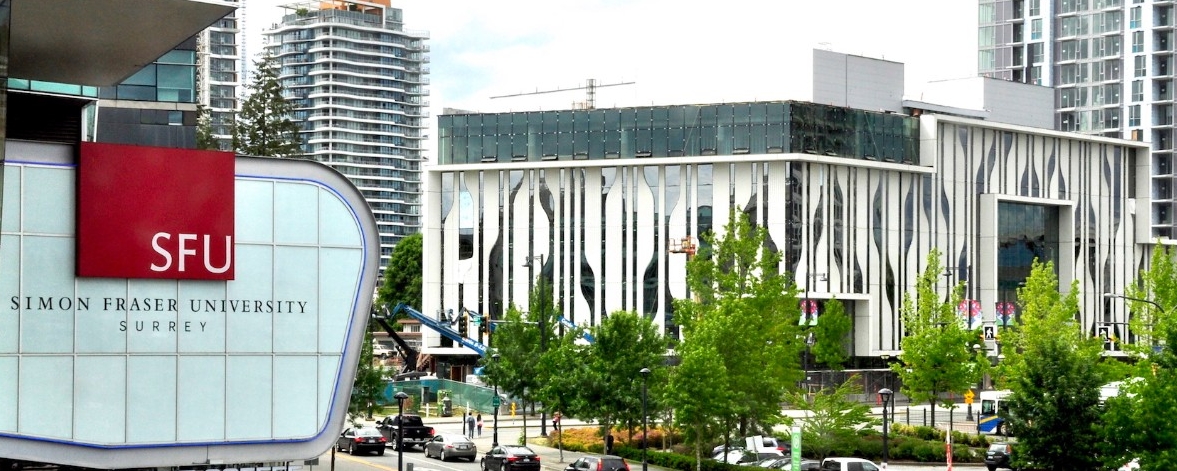
Emerging Media BC Community of Practice open Event on Friday April 12th 2019: Presentations & VR demos
The April 2019 meeting (details and RSVP here) will be hosted at the School of Interactive Arts and Technology (SIAT) at the SFU Surrey campus. The theme of this meeting is “VR 4Good”, based on the 4Good projects of the students at SIAR, with a focus on the benefits of facilitating such VR projects. Several of the VR4Good projects that were made during the Semester in Alternate Realities intensive (15 credit) course on the SFU Surrey campus will be presented.
These works were created by students from different SFU departments who joined our Semester in Alternate Realities. The works are part of an emerging field of development and research that use VR and other emerging technologies to increase awareness and be a catalyst for improving our world. These projects are the culmination of 14 weeks of an intense, iterative, agile, reflective and adaptive teaching and learning process. Four distinct yet interconnected “for good” Virtual Reality experiences focused on themes related to improving the social and environmental condition, by not only drawing awareness to issues in the world that require our attention, but also providing unique first-person experiences that we could not have without immersive technology.
Here’s a video of the presentations, starting with the student presentations:
starting with Bernhard and Patrick introducing the Semester in Alternate Realities:
and here is the part of the presentation where Bernhard and Patrick explain how they designed the “Semester in Alternate Realities” course and the important role that integrating student feedback on a regular (often daily) basis played.
Third and Final Showcase: Thursday April 4th 2019
We’ll have our third and final Student Virtual Reality Showcase on Thursday Aprtil 4th ‚ from ca 12pm noon — 5:30pm, on the SFU Surrey Campus Mezzanine, where our 18 students from different SFU departments will present their final projects. This time they all worked together in one Jazzile HiveMind ensemble instead of fixed teams to design this final experience.
Video trailer:

Projects and videos
Narrow Walls - You’re worth it, save your mind!
Narrow Walls is a VR experience that situates immersants into the role of war survivors trying to escape reality through transferring their consciousness into the virtual world. In the virtual world, the immersants learn about the background stories and motivations of other survivors who are in a similar situation. At the end of the experience, the immersants discover a surprising ending that reveals what the future holds for them.
Goal: Our intended goal for the immersant is to empathize with the risks that some refugees take to grant themselves or their family a better life. It is easy to generalize migrating refugees and come up with a preconceived expectation of each person that considers themselves as such, but by encompassing that group of refugees as individuals that come from different backgrounds and life experiences, we will make captivating characters. We want users to recognize these people as human beings with a tangible history, and that everyone can become a refugee even in developed countries.
Engaging with the NPCs in the world combined with the pre and post experiences will be what differentiates our experience from other experiences that tell the refugee experience. There are many VR experience that tells stories of refugees, but our experience will allow for more embodied experience for the user.
Core user experience: Narrow Walls is a nerve-wracking VR experience in which the users go through a harrowing exodus to an uncertain future while discovering about the tragic backgrounds of the people around them. The users will be situated in a confined space that is permeated by darkness where occasional flickers of light could be visible. A strong sense of uncertainty and fear would be conveyed to the users through the visual symbols. By placing the users in a virtual space where everything is in the dark and almost unperceivable, they are guided to feel the sense of uncertainty and fear that a refugee might feel on their journey to flee to a foreign country. The design of the NPCs in the virtual environment also helps to portray the metaphors of “fleeting memories” and “incomprehensibility of human future” as they are constantly glowing and disappearing, never fully visible.

Siege - Defend the mind palace
Welcome to the mind palace, a place in your mind you can go to in order to work through your personal troubles and issues. In the mind palace you will encounter your inner voice who will give you a tour. However, when a commotion is heard outside the tour is interrupted in order to go investigate. From the top of the castle tower, it becomes apparent that the castle is being bombarded with paper airplanes. Who is throwing these planes, and what do they want?
Goal: The goal of the project is to get the user to understand the importance of being connected to people, the significance of the community in their life, and their trust in those who surround them. Loneliness is a huge problem for many millennials and most of them don’t know how to tackle this problem. Our project is unique because the topic of loneliness and connection is not often explored in VR. We also use gamification to help users understand the topic. Siege may be considered as “for good” because it addresses an important topic of relying on others and how as a society we need to be connected to each other.
Core user experience: The core user experience of the project is to place the user in the position of being “attacked” by messages from their friends. The castle siege itself represents shutting oneself off from friends who are reaching out. The user is the one protecting the castle and fighting with the attackers who throw paper airplanes at them. However, some of the paper airplanes contain messages from the user’s friend, and through these messages and responses from the user’s “inner voice” the narrative is revealed. The desired shift that we want to achieve is to make the user realize that securing the castle (i.e. personal space and time) is sometimes not good, especially if we are ignoring those who are important to us in the process.
This emotional experience will assist in accomplishing our goal of making users value their personal relationships more and make them want to reach out to individuals in their lives to improve those relationships. When people understand the importance of connecting with others, they will incorporate this into their personal relationships and their community.

Aquatica - Sea the difference a cleaner ocean makes
Aquatica is a narrative-driven experience which brings users to a future job orientation where they will be asked to eliminate ocean life as bacteria-free plastic is considered as the only positive material to the ocean. In the ocean, users will see a variety of ocean creatures as well as different types of aesthetic plastic objects. Following the voice, users will help cleansing the ocean by eliminating ocean creatures such as sea cucumbers, plastic bag jellyfish, bleached corals, ugly fish, and a turtle. By presenting users with an illusion of a perfect futuristic ocean which is opposed to current conception, users will realize how plastic usage in daily life can negatively affect the ocean and the undersea creatures.
Goal: What makes Aquatica unique is that it is an underwater experience that takes place in a dystopian future where sea life has been driven to extinction by humans on purpose. The goal of the project is to raise awareness that if we do not control our usage of plastic and make people care about the ocean, then in the future, we may not have any left. We achieved this through sensory and imaginative immersion, in addition to trying to influence the user to make the unethical choice.
Core user experience: The core user experience of Aquatica involves encouraging the user to eliminate underwater creatures in a world where plastic is seen as clean and beautiful. By gradually ramping up the stakes, we hope users will realize the slippery slope oceans microplastics and undersea pollution can be.
Fit4You - Your Fitness, Personalized
(Real slogan: You don’t know yourself the way we do)
FIT4U is a virtual reality experience in which users are asked to workout with a virtual yoga instructor. Players fill in a form regarding their body and lifestyle information and before beginning their workout session. Once the experience is nearing completion, the simulation is revealed to be what it truly is; a way to farm their data. This is done to expose users to the “looseness” of cybersecurity, and how it can be easily manipulated to aid cyber-criminals in accessing user data and companies in exploiting their data.
Goal: FIT4U intends to raise awareness of cybersecurity through a VR experience where the user is tricked into sharing personal information. The setting for the experience is a relaxing and almost meditative environment in order to make the users feel more at ease. The major differentiator of FIT4U is that it takes the issue of cybersecurity to a personal level, unlike similar VR experiences that gamify the issue. FIT4U closes this gap by making the user a victim of fictional cybercrime where their real personal information is accessed by a hacker. Such an effect should create a shift in the user’s perception of the problem and help them realize that they need to be more careful about the information they share.
Core user experience: Shift. We want to trick the user into giving away information, so we can show how careless they are with it. We want users to feel relaxed enough so they become more manipulatable and are more willing to give away their data. We would like users to feel meditative and comfortable as they go through the yoga workout process then shocked when they discover that all their information was accessed by someone else after the fictional data breach. The transition from comfort to shock is crucial since it removes the abstract gap between the user sharing their personal information and someone else taking advantage of it. We want FIT4U to be an educational experience and we believe our experience triggers additional thinking process and conscious shift in the users’ mindset towards a more aware lifestyle.

Pictures from our third and final showcase
VR demo at: "How to Stay Afloat: Tackling the Oceans & Climate Change"
SIAR students presented their course VR project during the “Let’s talk Climate Change & the Oceans” event on the Burnaby campus which had the topic of “How to Stay Afloat: Tackling the Oceans & Climate Change”
Second Showcase: Fr March 8th 2019
We’ll have our second Student Virtual Reality Showcase on Friday March 8th, from ca 12pm noon - 4:30pm, on the SFU Surrey Campus Mezzanine, where our 18 students from different SFU departments created new teams and designed new projects to showcase. See our Facebook event page for first pictures of the showcase, more will follow soon.
Fit4U: Your Fitness, Personalized
(Real slogan: You don’t know yourself the way we do)
FIT4U is a virtual reality experience in which users are asked to workout with a real coach. Players fill the form regarding their body and lifestyle information and begin their workout session. Once the experience is nearing completion, the simulation is revealed to be what it truly is; a way to farm their data. This is done to expose users to the “looseness” of cybersecurity, and how it can be easily manipulated to aid cyber-criminals in accessing user data and companies in exploiting their data.
Goal: FIT4U intends to raise awareness on cybersecurity issue using VR experience where the user is tricked into sharing personal information in the relaxing and almost meditative environment, analogous to many cases in the real world. The major differentiator is that FIT4U takes issue of a cybersecurity onto a personal level, unlike many projects out there since similar VR experiences focus on game-like feel which detracts from the real problem. FIT4U closes this gap by making the user a victim of fictional cyber crime where their real personal information is accessed by a hacker. Such an effect should make a shift in user’s perception on a problem and help them realize that they need to be more careful about the information they share.
Core user experience: We want to trick the user into giving away information, so we can show how careless they are with it. We want users to feel relaxed enough so they become more manipulable and are more willing to give away their data. We would like users to feel meditative and comfortable as they go through the yoga workout process and shocked as soon as they discover that all their information entered within the software as well as their information from the Web was accessed by someone else after the fictional data breach. Transition from comfort to shock is crucial since it removes the abstract gap between the user sharing their personal information and someone else taking advantage of it. We want FIT4U to be an educational experience and we believe our experience triggers additional thinking process and conscious shift in the users’ mindset towards a more aware lifestyle.

CyberPsych Inc.: The prototype of your dreams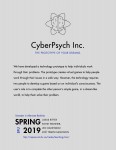
We are a corporation called CyberPsych Inc. and we have developed a technology prototype that creates virtual games to help people work through their issues in a safe way. However, the technology requires two people to develop a game based on an individual’s consciousness. Your role is to complete the other person’s simple game, in the dream-like world, to help them solve their problem.
Goal: The goal of the project is to get the user understand the importance of being connected to people, the significance of the community in their life, and their trust in those who surround them. Loneliness is a huge problem for many millennials and most of them don’t know how to tackle this problem.
Core user experience: The core user experience of the project is to place the user in the position of being “attacked” by messages from their friends. The castle siege itself represents shutting oneself off from friends who are reaching out. The user is the one protecting the castle and fighting with the attackers who shoot arrows at them. In the end, the user realises that the arrows have messages attached to them, and that they have failed to communicate with their friends. The desired shift that we want to achieve is to make the user realize that securing the castle (i.e. personal space and time) is sometimes not good, especially if we are ignoring those who are important to us in the process.
This emotional experience will assist in accomplishing our goal of making users value their personal relationships more and make them want to reach out to individuals in their lives to improve those relationships. When people understand the importance of connecting with others, so they will incorporate this in their personal relationships and their community.

Narrow Walls: We are humans just like you
Narrow Walls is a VR experience that puts immersants into the role of a refugee trying to escape reality via the back of a virtual cargo truck. While being transported in the truck, the immersant will be able to move around the confined cargo space, and interact with the other refugees that they are travelling with. Each of the NPC’s will offer their own background stories and personal motivations for wanting to be smuggled into another country.
Goal: Our intended goal for the immersant is to empathize with the risks that some refugees take to grant themselves or their family a better life. It is easy to generalize migrating refugees and come up with a preconceived expectation of each person that considers themselves as such, but by encompassing that group of refugees as individuals that come from different backgrounds and life experiences, we will make captivating characters. We want users to recognize these people as human beings with life a tangible history, and not just victims of unfortunate political, economical or social circumstance. Interaction with the NPCs in the world and movement within a virtual environment will be what differentiates our experience from other experience that tell the refugee experience. There are many VR experience that tell stories of refugees, but our experience will allow for more embodied experience for the user.
Core user experience: Narrow Walls is a nerve racking VR experience in which the users go through a harrowing exodus to an uncertain future while discovering about the tragic backgrounds of the people that have found themselves in the same dire circumstances: a shipping container on the back of a truck.

Aquatica: Sea the difference a cleaner ocean makes
Aquatica is a narrative driven experience which brings users to a dystopian future where oceans are cleaned up and filled with bacteria-free plastics. In the underwater environment, users can follow the pink orbs to teleport to different locations to see a variety of new “sea creatures” and hear stories about them. At the end of the experience, users will be presented with a choice which will influence the post experience. After taking off the VR headset, users will be given a bottle of “microplastic” and be told of the impact of microplastic on sea lifes, they come to realize that how plastic can impact the life of many undersea creatures.
Goal: What makes Aquatica unique is that it is an underwater experience that takes place in a dystopian future where sea life has been driven to extinction. The goal of the project is to raise awareness that if we do not control our usage of plastic and make people care about the ocean, then in the future, we may not have any left. We achieved this through sensory and imaginative immersion, in addition to subtly trying to influence the user to make the unethical choice.
Core user experience: The core user experience within Aquatica is creating a connection with users, by presenting a bizarre world in which plastic is seen as a positive, we hope to surprise users and make them reflect on why plastic is imitating organic sea life. In doing so, we expect it will help remind users about the importance of plastic and its impact on the ocean.
Showcase 2 pictures
Demos at FCAT undergraduate Conference on March 1st 2019
See also the Flickr galery from the conference.
First Showcase: Fr February 1st 2019
We’ll have our first Student Virtual Reality Showcase on Friday February 1st, ca 1:00 - 4:30pm, on the SFU Surrey Campus Mezzanine, where the 18 students from different SFU departments show their first immersive project. Below are their project videos and brief project descriptions. See our facebook event page for first pictures of the showcase, more will follow soon.
Media coverage: http://www.sfu.ca/fcat/news/news-archive/spring-2019/students-in-sfu_s-new-semester-in-alternate-realities-teach-peop.html
Rising Waters: Is this your future?
Rising Waters is an exploratory context driven game that sets you in the future, in which pollution has devastated the planet. Through narrative and context clues, the player is set to navigate the world and automatically obtaining samples within their robotic suite to see how a low-lying coastal city has been damaged through careless environmental damage. Once the mission is complete, the player exits the experience and reflects on their own environmental impact.
Goal: The goal of this project is to prompt participants to consider the long-term impact of their actions on the environment through visual, auditory and experiential learning. By situating the participant in a familiar location, city banners are used to help localize the experience, participants will learn about how a localized city can be impacted through a lack of immediate change towards combating global and local pollutants, affect how the biosphere behaves, which can contribute to rising sea levels, and degradation in the overall quality of the environment.
Core User Experience: The core user experience centers around narrative and experiential learning through interaction with the built environment. In Rising Waters, the focus of attention first and foremost should be on how the user interacts with the built environment, driving the core experience to be exploratory in nature. By having participants interact with the environment, Rising Waters wants to confront the user’s initial sense of awe, with one of dread and shock. Ideally, the user experience presents itself as something nouveau, driving forward a sense of urgency that imbues the user with a desire to complete the experience.

Restless Sleep - A Waking Coma Experience: To find the forest through the eyes of others 
“Restless Sleep” is an innovative VR experience of a fabulated narrative in which users’ mind is connecting with the consciousness of coma patient in order to see and feel through a comatose perception. The experience is composed by both performative and virtual elements, incorporating interactive responses between haptics and visuals, to guide users into the full embodiment of a coma patient, who is constantly feeling and interacting with their physical environment.
Goal: Our goal of the project is to let the user foster empathy towards coma patients. Many people question how conscious of their surroundings Coma patients are and how much outside stimulation they can actually interpret. By being in a VR coma experience (per, during and post), the users are put into the shoes of a coma patient where they can learn how coma patients are treated and also to show that they have a mind of their own which are not fully unconscious.
Core User Experience: The core user experience we want to accomplish is to foster empathy for coma patients and develop an understanding of what they can feel and how bystander actions can influence the mental state along with the mental interpretations of the patient. We want users to walk away from the experience with a sense of introspective contemplation, and hopefully knowledge on how best to handle themselves around people in comas (or even those in other states of altered consciousness). This is because we identified a surprising amount of misinformation and ignorance surrounding comatose states, as well
as many first-hand experiences of comatose patients. The most impactful was the story of a girl who was in a two week medically induced coma and her recounts of the hallucinatory dreams she had while in the coma.. While we deliberately didn’t want to subject the users to this, we did want to bring attention to the feeling of helplessness one feels, and how it is analogous to being in VR — especially in a public setting.
https://vimeo.com/315911417/b084425816
The Pitch of Red: Every colour has a voice
The Pitch of Red is an immersive VR experience that allows the user to experience synesthesia — a condition that blends two or more senses together. In our experience, users are able to hear the sounds of the colours they see as they wander through the mind of Wassily Kandinsky — an artist who had such a condition.
Goal: The project tries to bring the user closer to the notion of mixing human senses. The psychological deviation can be experienced by anyone to any extent. It is mostly based on what the person associated with a certain sound, colour, taste or any other humanly understood medium. The amount of people who experience that feeling is relatively small, however, the impact they have made in history or their way of perceiving the world is worth studying. The project is focused on communicating the idea of mixing human senses, also known as — synesthesia to those who have never heard something similar to that or never experienced that sense.
Core user experience: For The Pitch of Red we aim to provide immersants with a greater understanding of what it is like to have synesthesia of associating colors to sounds, or at the very least, be able to describe what such synesthesia is to someone who may not know what it means. During the experience they will be granted a “superpower”: being able to hear every colour that they look at and we would expect users to feel curious, excited and intentionally a bit overwhelmed. After finishing our VR experience, we would like users will come out with a better understanding of what this particular type of synesthesia might feel like in real life.
Aesthetically, we want the experience to allow the immersant to see an alternate reality through the eyes of Wassily Kandinsky. With that said, one of the difficulties of VR is the lack of haptic touch so our focus with The Pitch of Red is to try to simulate the relationship between sight and sound.
Barriers: The TRIP of a lifetime 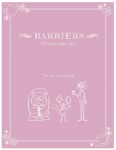
BARRIERS is a virtual experience that allows the user to view interactions through the eyes and ears of a Non-Native English speaker. After biting into a “magical” cookie, the participant is transported to a fantasy world. In order to achieve their goal of finding a washroom, the immersant must interact with nearby talking animals.
Goal: The main emotion we are trying to evoke in our experience is the vulnerability of relying on other people to be willing to help you when they don’t understand what they are saying. What makes our project unique is its ability to make anyone feel as though they do not understand the language since it is made up. This ties in with the course theme because it invokes empathy in the user and give them an experience they would not otherwise have access to.
Core user experience:
Through BARRIERS, we hope to place users in the vulnerable position of relying on other people for help. This experience aims to recreate the frustration that comes with not being able to speak English and the gratitude that arises when an individual takes the time to explain and use different communication techniques to foster understanding.

